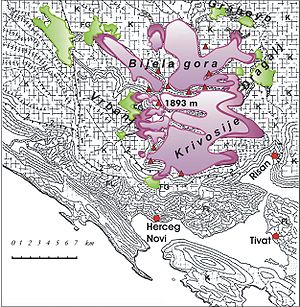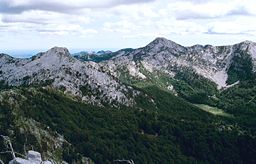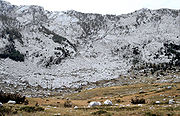
Glaciokarst
Encyclopedia




Karst topography
Karst topography is a geologic formation shaped by the dissolution of a layer or layers of soluble bedrock, usually carbonate rock such as limestone or dolomite, but has also been documented for weathering resistant rocks like quartzite given the right conditions.Due to subterranean drainage, there...
that was glaciated
Glacier
A glacier is a large persistent body of ice that forms where the accumulation of snow exceeds its ablation over many years, often centuries. At least 0.1 km² in area and 50 m thick, but often much larger, a glacier slowly deforms and flows due to stresses induced by its weight...
during the cold periods of the Pleistocene
Pleistocene
The Pleistocene is the epoch from 2,588,000 to 11,700 years BP that spans the world's recent period of repeated glaciations. The name pleistocene is derived from the Greek and ....
and displays major landforms of glacial influence. For this reason karstification can be pre- and/or post- Pleistocene, this is not easy to classifiy. Mostly Glaciokarst has not such distinctly karst landforms.
Good examples of glaciokarst landscapes are found in the Dinaric Alps
Dinaric Alps
The Dinaric Alps or Dinarides form a mountain chain in Southern Europe, spanning areas of Slovenia, Croatia, Bosnia and Herzegovina, Serbia, Kosovo, Albania and Montenegro....
especially at Orjen
Orjen
Orjen is a Dinaric Mediterranean limestone mountain range in Montenegro-Bosnia and Herzegovina. At 1894 m , Zubački kabao is the highest peak in the subadriatic Dinarides. The massif of Orjen lies to the Northwest of Risan in Bay of Kotor...
.
Care should be taken to distinguish between glaciokarst and thermokarst
Thermokarst
Thermokarst is a land surface characterised by very irregular surfaces of marshy hollows and small hummocks formed as ice-rich permafrost thaws, that occurs in Arctic areas, and on a smaller scale in mountainous areas such as the Himalayas and the Swiss Alps...
. The latter is related to karst-like topography developed on glacier surfaces (usually with a thickness of weathered rock fragments on the surface). It has also been used to indicate karst-like features developed on permafrost
Permafrost
In geology, permafrost, cryotic soil or permafrost soil is soil at or below the freezing point of water for two or more years. Ice is not always present, as may be in the case of nonporous bedrock, but it frequently occurs and it may be in amounts exceeding the potential hydraulic saturation of...
(ice-rich ground).

